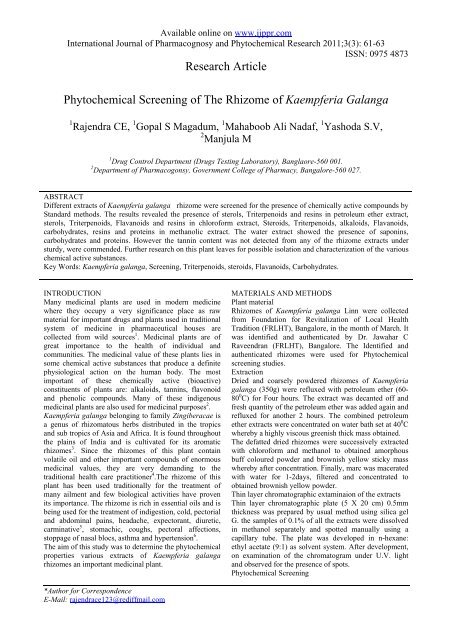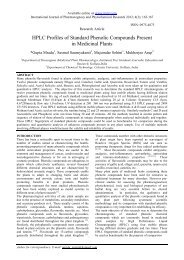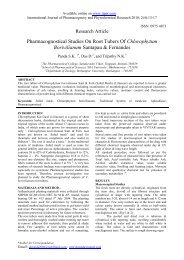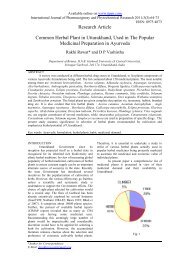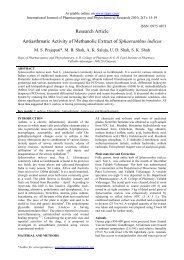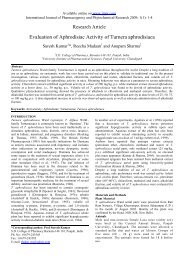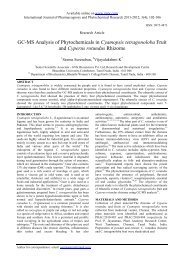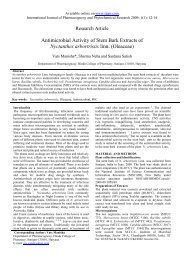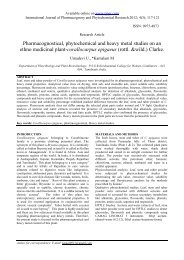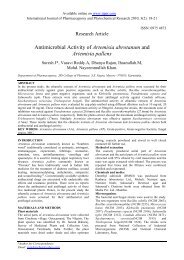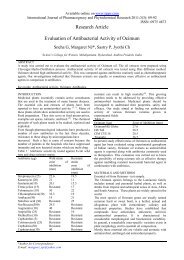phytochemical screening of the rhizome of kaempferia galanga
phytochemical screening of the rhizome of kaempferia galanga
phytochemical screening of the rhizome of kaempferia galanga
Create successful ePaper yourself
Turn your PDF publications into a flip-book with our unique Google optimized e-Paper software.
Available online on www.ijppr.com<br />
International Journal <strong>of</strong> Pharmacognosy and Phytochemical Research 2011;3(3): 61-63<br />
ISSN: 0975 4873<br />
Research Article<br />
Phytochemical Screening <strong>of</strong> The Rhizome <strong>of</strong> Kaempferia Galanga<br />
1 Rajendra CE, 1 Gopal S Magadum, 1 Mahaboob Ali Nadaf, 1 Yashoda S.V,<br />
2 Manjula M<br />
1 Drug Control Department (Drugs Testing Laboratory), Banglaore-560 001.<br />
2 Department <strong>of</strong> Pharmacogonsy, Government College <strong>of</strong> Pharmacy, Bangalore-560 027.<br />
ABSTRACT<br />
Different extracts <strong>of</strong> Kaempferia <strong>galanga</strong> <strong>rhizome</strong> were screened for <strong>the</strong> presence <strong>of</strong> chemically active compounds by<br />
Standard methods. The results revealed <strong>the</strong> presence <strong>of</strong> sterols, Triterpenoids and resins in petroleum e<strong>the</strong>r extract,<br />
sterols, Triterpenoids, Flavanoids and resins in chlor<strong>of</strong>orm extract, Steroids, Triterpenoids, alkaloids, Flavanoids,<br />
carbohydrates, resins and proteins in methanolic extract. The water extract showed <strong>the</strong> presence <strong>of</strong> saponins,<br />
carbohydrates and proteins. However <strong>the</strong> tannin content was not detected from any <strong>of</strong> <strong>the</strong> <strong>rhizome</strong> extracts under<br />
sturdy, were commended. Fur<strong>the</strong>r research on this plant leaves for possible isolation and characterization <strong>of</strong> <strong>the</strong> various<br />
chemical active substances.<br />
Key Words: Kaempferia <strong>galanga</strong>, Screening, Triterpenoids, steroids, Flavanoids, Carbohydrates.<br />
INTRODUCTION<br />
Many medicinal plants are used in modern medicine<br />
where <strong>the</strong>y occupy a very significance place as raw<br />
material for important drugs and plants used in traditional<br />
system <strong>of</strong> medicine in pharmaceutical houses are<br />
collected from wild sources 1 . Medicinal plants are <strong>of</strong><br />
great importance to <strong>the</strong> health <strong>of</strong> individual and<br />
communities. The medicinal value <strong>of</strong> <strong>the</strong>se plants lies in<br />
some chemical active substances that produce a definite<br />
physiological action on <strong>the</strong> human body. The most<br />
important <strong>of</strong> <strong>the</strong>se chemically active (bioactive)<br />
constituents <strong>of</strong> plants are: alkaloids, tannins, flavonoid<br />
and phenolic compounds. Many <strong>of</strong> <strong>the</strong>se indigenous<br />
medicinal plants are also used for medicinal purposes 2 .<br />
Kaempferia <strong>galanga</strong> belonging to family Zingiberacae is<br />
a genus <strong>of</strong> rhizomatous herbs distributed in <strong>the</strong> tropics<br />
and sub tropics <strong>of</strong> Asia and Africa. It is found throughout<br />
<strong>the</strong> plains <strong>of</strong> India and is cultivated for its aromatic<br />
<strong>rhizome</strong>s 3 . Since <strong>the</strong> <strong>rhizome</strong>s <strong>of</strong> this plant contain<br />
volatile oil and o<strong>the</strong>r important compounds <strong>of</strong> enormous<br />
medicinal values, <strong>the</strong>y are very demanding to <strong>the</strong><br />
traditional health care practitioner 4 .The <strong>rhizome</strong> <strong>of</strong> this<br />
plant has been used traditionally for <strong>the</strong> treatment <strong>of</strong><br />
many ailment and few biological activities have proven<br />
its importance. The <strong>rhizome</strong> is rich in essential oils and is<br />
being used for <strong>the</strong> treatment <strong>of</strong> indigestion, cold, pectorial<br />
and abdominal pains, headache, expectorant, diuretic,<br />
carminative 5 , stomachic, coughs, pectoral affections,<br />
stoppage <strong>of</strong> nasal blocs, asthma and hypertension 6 .<br />
The aim <strong>of</strong> this study was to determine <strong>the</strong> <strong>phytochemical</strong><br />
properties various extracts <strong>of</strong> Kaempferia <strong>galanga</strong><br />
<strong>rhizome</strong>s an important medicinal plant.<br />
MATERIALS AND METHODS<br />
Plant material<br />
Rhizomes <strong>of</strong> Kaempferia <strong>galanga</strong> Linn were collected<br />
from Foundation for Revitalization <strong>of</strong> Local Health<br />
Tradition (FRLHT), Bangalore, in <strong>the</strong> month <strong>of</strong> March. It<br />
was identified and au<strong>the</strong>nticated by Dr. Jawahar C<br />
Raveendran (FRLHT), Bangalore. The Identified and<br />
au<strong>the</strong>nticated <strong>rhizome</strong>s were used for Phytochemical<br />
<strong>screening</strong> studies.<br />
Extraction<br />
Dried and coarsely powdered <strong>rhizome</strong>s <strong>of</strong> Kaempferia<br />
<strong>galanga</strong> (350g) were refluxed with petroleum e<strong>the</strong>r (60-<br />
80 0 C) for Four hours. The extract was decanted <strong>of</strong>f and<br />
fresh quantity <strong>of</strong> <strong>the</strong> petroleum e<strong>the</strong>r was added again and<br />
refluxed for ano<strong>the</strong>r 2 hours. The combined petroleum<br />
e<strong>the</strong>r extracts were concentrated on water bath set at 40 0 C<br />
whereby a highly viscous greenish thick mass obtained.<br />
The defatted dried <strong>rhizome</strong>s were successively extracted<br />
with chlor<strong>of</strong>orm and methanol to obtained amorphous<br />
buff coloured powder and brownish yellow sticky mass<br />
whereby after concentration. Finally, marc was macerated<br />
with water for 1-2days, filtered and concentrated to<br />
obtained brownish yellow powder.<br />
Thin layer chromatographic extaminaion <strong>of</strong> <strong>the</strong> extracts<br />
Thin layer chromatographic plate (5 X 20 cm) 0.5mm<br />
thickness was prepared by usual method using silica gel<br />
G. <strong>the</strong> samples <strong>of</strong> 0.1% <strong>of</strong> all <strong>the</strong> extracts were dissolved<br />
in methanol separately and spotted manually using a<br />
capillary tube. The plate was developed in n-hexane:<br />
ethyl acetate (9:1) as solvent system. After development,<br />
on examination <strong>of</strong> <strong>the</strong> chromatogram under U.V. light<br />
and observed for <strong>the</strong> presence <strong>of</strong> spots.<br />
Phytochemical Screening<br />
*Author for Correspondence<br />
E-Mail: rajendrace123@rediffmail.com
Rajendra et. al. / Phytochemical Screening <strong>of</strong>……<br />
Table 1: Phytochemical constituents <strong>of</strong> Petroleum e<strong>the</strong>r, Chlor<strong>of</strong>orm, methanol and water extracts <strong>of</strong> Kaempferia<br />
<strong>galanga</strong> <strong>rhizome</strong><br />
Sl.No. Test Pet e<strong>the</strong>r<br />
extract<br />
Chlor<strong>of</strong>orm extract Methanolic extract Water<br />
extract<br />
1 Sterols and triterpenoid + + + -<br />
2 Alkaloids - - + -<br />
3 Saponins - - - +<br />
4 Tannins - - - -<br />
5 Flavonoids - + + -<br />
6 Carbohydrates - - + +<br />
7 Resins + + + -<br />
8 Proteins - - + +<br />
Present (+); absent (-).<br />
Phytochemical Screening for all <strong>the</strong> extracts were<br />
performed using standard procedures.<br />
1. Test for Sterols and Triterpenoids: 25mg chlor<strong>of</strong>orm<br />
and methanolic extracts were dissolved in chlor<strong>of</strong>orm,<br />
filtered and filtrate was tested for sterols and<br />
Triterpenoids.<br />
a. Salkowski’s Test: Few drops <strong>of</strong> concentrated sulphuric<br />
acid were added to chlor<strong>of</strong>orm solution and observed for<br />
Red colour in lower layer for sterols and golden yellow<br />
colour indicates <strong>the</strong> presence <strong>of</strong> Triterpenoids.<br />
b. Libermann Buchard test: Few drops <strong>of</strong> acetic anhydride<br />
were added to chlor<strong>of</strong>orm solution, shaken well. 1ml <strong>of</strong><br />
concentrated sulphuric acid carefully added from sides <strong>of</strong><br />
<strong>the</strong> test tube. A reddish brown coloration indicates <strong>the</strong><br />
presence <strong>of</strong> sterols and Red ring indicates <strong>the</strong> presence <strong>of</strong><br />
Triterpenoids.<br />
2. Test for Alkaloids: 0.5g <strong>of</strong> extracts were diluted<br />
separately to 10ml with acid alcohol, boiled and filtered.<br />
To 5ml <strong>of</strong> <strong>the</strong> filtrate was added 2ml <strong>of</strong> dilute ammonia.<br />
5ml <strong>of</strong> chlor<strong>of</strong>orm was added and shaken gently to extract<br />
<strong>the</strong> alkaloid base. The chlor<strong>of</strong>orm layer was extracted<br />
with 10ml <strong>of</strong> acetic acid. These were divided in to 3<br />
portions.<br />
a. Dragendr<strong>of</strong>f’s Test: (Potassium Bismuth Nitrate): Few<br />
drops <strong>of</strong> Dragendr<strong>of</strong>f’s solution added to Chlor<strong>of</strong>orm<br />
solution, Reddish brown precipitate indicates <strong>the</strong> presence<br />
<strong>of</strong> alkaloids.<br />
b. Mayer’s Test: (Potassium Mercuric Iodide): Few drops<br />
<strong>of</strong> Mayer’s Reagent added to Chlor<strong>of</strong>orm solution,<br />
Creamy white precipitate indicated <strong>the</strong> presence <strong>of</strong><br />
alkaloids.<br />
c. Wagner’s Test: (Iodine in Potassium Iodide): Few<br />
drops <strong>of</strong> Wagner’s solution added to chlor<strong>of</strong>orm solution,<br />
Brown precipitate indicate <strong>the</strong> presence <strong>of</strong> alkaloids.<br />
3. Test for Saponins:<br />
a. Foam Test: To 0.5gm <strong>of</strong> extract was added 5ml <strong>of</strong><br />
distilled water in a test tube. The solution was shaken<br />
vigorously and observed for a stable persistent froth. The<br />
frothing was mixed with 3 drops <strong>of</strong> olive oil and shaken<br />
vigorously after which it was observed for <strong>the</strong> formation<br />
<strong>of</strong> an emulsion.<br />
b. Haemolysis Test: To 2ml <strong>of</strong> 1.8% Nacl solution taken<br />
in two test tubes, 2ml <strong>of</strong> distilled water added to one <strong>of</strong><br />
<strong>the</strong> test tube and 2ml <strong>of</strong> 1.0% extract was added to<br />
ano<strong>the</strong>r test tube, 5 drops <strong>of</strong> blood was added to each test<br />
tube and gently mixed <strong>the</strong> contents and observed under<br />
microscope. If haemolysis observed in <strong>the</strong> test tube<br />
containing <strong>the</strong> extract, it indicates <strong>the</strong> presence <strong>of</strong><br />
saponins.<br />
4. Test for Tannins:<br />
a. Ferric Chloride Test: About 0.5gm <strong>of</strong> <strong>the</strong> extract was<br />
boiled in 10ml <strong>of</strong> water in a test tube and <strong>the</strong>n filtered. A<br />
few drops <strong>of</strong> 0.1% ferric chloride was added and<br />
observed for brownish green or a blue-black coloration.<br />
b. Gelatin Test: Few ml <strong>of</strong> 1% solution <strong>of</strong> gelatin in 10%<br />
Sodium chloride was added to <strong>the</strong> above extract and<br />
observed for white precipitate indicates <strong>the</strong> presence <strong>of</strong><br />
Tannins.<br />
5. Test for Flavonoids: Three methods were used to test<br />
for flavonoids. First, few drops <strong>of</strong> 1% neutral ferric<br />
chloride to a portion <strong>of</strong> an aqueous filtrate <strong>of</strong> <strong>the</strong> extract.<br />
A blackish green coloration that produced on standing<br />
indicates <strong>the</strong> presence <strong>of</strong> flavonoids. Second, A few drops<br />
<strong>of</strong> 10% lead acetate solution were added to a portion <strong>of</strong><br />
<strong>the</strong> extract. A yellow precipitates indicates <strong>the</strong> presence<br />
<strong>of</strong> flavonoids. Third, a portion <strong>of</strong> <strong>the</strong> extract was<br />
dissolved in <strong>the</strong> methanol, to this a small piece <strong>of</strong><br />
magnesium ribbon was added, one ml <strong>of</strong> concentrated<br />
Hydrochloric added from <strong>the</strong> side <strong>of</strong> <strong>the</strong> test tube. A<br />
magenta colour indicates <strong>the</strong> presence <strong>of</strong> flavonoids.<br />
6. Test for carbohydrates: 100mg <strong>of</strong> methanolic and<br />
water extracts were dissolved in little quantity <strong>of</strong> distilled<br />
water and filtered. The filtrate was used to test <strong>the</strong><br />
presence <strong>of</strong> carbohydrates. There are four methods were<br />
used to test for carbohydrates.<br />
a. Fehling’s test: The filtrate was hydrolyzed with dil Hcl,<br />
neutralized with alkali and heated with Fehling’s solution<br />
A and B. The formation <strong>of</strong> Red precipitates indicates <strong>the</strong><br />
presence <strong>of</strong> reducing sugars.<br />
b. Barfoed’s test: Few ml <strong>of</strong> Barfoed’s reagent was added<br />
to <strong>the</strong> filtrate and boiled in a water bath. The formation<br />
<strong>of</strong> Reddish precipitates indicates <strong>the</strong> presence <strong>of</strong><br />
Monosaccharide.<br />
c. Molisch’s test: Few ml <strong>of</strong> Molisch’s reagent were<br />
added to <strong>the</strong> filtrate and concentrated sulphuric acid was<br />
added along <strong>the</strong> sides <strong>of</strong> <strong>the</strong> test tube. The formation <strong>of</strong><br />
Reddish violet ring indicates <strong>the</strong> presence <strong>of</strong><br />
Carbohydrates.<br />
IJPPR September - November 2011, Volume 3, Issue 3(61-63) 62
Rajendra et. al. / Phytochemical Screening <strong>of</strong>……<br />
d. Benedict’s Test: Few ml <strong>of</strong> Benedict’s reagent was<br />
added to <strong>the</strong> filtrate and heated. A reddish orange<br />
precipitate indicates <strong>the</strong> presence <strong>of</strong> reducing sugars.<br />
7. Test for Resins: Two methods were used to test for<br />
resins. First, 0.5gm <strong>of</strong> <strong>the</strong> extract was diluted to 10 ml<br />
with water and shaken for 5 minutes. The formation <strong>of</strong><br />
turbidity indicates <strong>the</strong> presence <strong>of</strong> Resins. Second, <strong>the</strong><br />
methanolic extract was dissolved in 5 to 10ml <strong>of</strong> acetic<br />
anhydride by gentle heating and cooled. To this, 0.5ml <strong>of</strong><br />
Sulphuric acid was added. The formation <strong>of</strong> Bright<br />
purplish red colour changes to violet colour indicates <strong>the</strong><br />
presence <strong>of</strong> resins.<br />
8. Test for Proteins: Two methods were used to test for<br />
proteins. First, few ml <strong>of</strong> 0.1% <strong>of</strong> copper sulphate<br />
solution was added to <strong>the</strong> aqueous solution <strong>of</strong> extract<br />
containing 10% sodium hydroxide. The formation <strong>of</strong><br />
violet or pink colour indicates <strong>the</strong> presence <strong>of</strong> proteins.<br />
Second, freshly prepared Ninhydrin reagent was added to<br />
<strong>the</strong> aqueous solution <strong>of</strong> <strong>the</strong> extract and boiled for few<br />
minutes, allowed to cool. The formation <strong>of</strong> violet or<br />
purple colour indicates <strong>the</strong> presence <strong>of</strong> proteins.<br />
RESULTS<br />
The <strong>phytochemical</strong> <strong>screening</strong> analysis <strong>of</strong> all <strong>the</strong> extracts<br />
<strong>of</strong> Kaempferia <strong>galanga</strong> <strong>rhizome</strong> shows that <strong>the</strong> petroleum<br />
e<strong>the</strong>r, chlor<strong>of</strong>orm and methanolic extracts showed <strong>the</strong><br />
presence <strong>of</strong> sterols and triterpenoids, flavonoids and<br />
resins. Methanolic extract showed <strong>the</strong> presence <strong>of</strong><br />
alkaloids and water extracts showed <strong>the</strong> presence <strong>of</strong><br />
saponins. The chlor<strong>of</strong>orm and methanolic extract showed<br />
<strong>the</strong> presence <strong>of</strong> flavonoids. The methanolic and water<br />
extracts showed <strong>the</strong> presence <strong>of</strong> carbohydrates and<br />
proteins. The thin layer chromatography revealed that <strong>the</strong><br />
clearly visible spots has been identified in <strong>the</strong> methanolic<br />
extract <strong>of</strong> <strong>the</strong> <strong>rhizome</strong> when compared with <strong>the</strong> standard<br />
Ethyl-p-methoxy cinnamate.<br />
DISCUSSION<br />
The <strong>phytochemical</strong> <strong>screening</strong> analysis <strong>of</strong> <strong>the</strong> Kaempferia<br />
<strong>galanga</strong> <strong>rhizome</strong> extract has showed <strong>the</strong> presence <strong>of</strong><br />
different constituents in <strong>the</strong> extracts. The sterols and<br />
triterpenoids were found to be present in petroleum e<strong>the</strong>r,<br />
chlor<strong>of</strong>orm and methanolic extracts. The alkaloid content<br />
was identified in methanolic extract, Saponin content was<br />
mainly present in water extract and Tannins was totally<br />
absent in all <strong>the</strong> extracts. The flavonoid content was<br />
found to be present in chlor<strong>of</strong>orm and methanolic extract,<br />
Carbohydrates was found to be present in methanol and<br />
extracts, Resins was found to be present in Petroleum<br />
e<strong>the</strong>r, Chlor<strong>of</strong>orm and Methanolic extracts, and proteins<br />
was found to be present in methanolic and water extracts.<br />
CONCLUSION<br />
It has been concluded that <strong>the</strong> <strong>rhizome</strong> extracts <strong>of</strong> <strong>the</strong><br />
Kaempferia <strong>galanga</strong> (Zingiberaceae) showed <strong>the</strong><br />
presence <strong>of</strong> sterols, triterpenoids, alkaloids, saponins,<br />
flavonoids, carbohydrates and proteins.<br />
REFERENCES<br />
1. Sani Ali Audu, Ilyas Mohammed, Haruna Abdul Kaita.<br />
Phytochemical <strong>screening</strong> <strong>of</strong> <strong>the</strong> leaves <strong>of</strong> Lophira<br />
lanceolata (Ochanaceae). Life science Journal,<br />
2007:4(4):75-79.<br />
2. O.O.Aiyelaagbe and Paul M. Osamudiamen,<br />
Phytochemical <strong>screening</strong> for active compounds in<br />
Mangifera indica leaves from Ibadan, Oyo State. Plant<br />
science Research 2009;2(1):11-13.<br />
3. Geetha SP, Manjula C, John CZ, Minoo D, Nirmal<br />
Babu K and Ravindran PN. Micropropagation <strong>of</strong><br />
Kaempferia spp. (K. <strong>galanga</strong> and K. Rotunda L.). Journal<br />
<strong>of</strong> Spices and Aromatic Crops 1997; 6(2):129-135.<br />
4. Rahman MM, Amin MN, Ahamed T. Ahmad S. In<br />
vitro rapid propagation <strong>of</strong> Black Thorn (Kaempferia<br />
<strong>galanga</strong> L.): A Rare Medicianl and Aromatic Plant <strong>of</strong><br />
Bangladesh. Journal <strong>of</strong> Biological Sciences<br />
2005;5(3):300-304.<br />
5. Jagadish PC. Raghu Chandrashekhar H, Vinod kumar<br />
S and Latha KP. Potent selective Cytotoxic activity <strong>of</strong><br />
Kaempferia <strong>galanga</strong> L. <strong>rhizome</strong> against cancer cell<br />
cultures. International journal <strong>of</strong> Pharma and<br />
Biosciences 2010;1(2):1-5.<br />
6. Rahman MM, Amin MN, Ahamed T. Ali MR and<br />
Habib A. Efficient plant regeneration through somatic<br />
embryogenesis from leaf base-derived callus <strong>of</strong><br />
Kaempferia <strong>galanga</strong> L. Asian journal <strong>of</strong> plant sciences<br />
2004;3(6):675-678.<br />
7. Supinya Tewtrakul, Supreeya Yuenyongsawad, Sopa<br />
Kummee and Latthya Atsawajaruwan. Chemical<br />
components and biological activities <strong>of</strong> volatiole oil <strong>of</strong><br />
Kaempferia <strong>galanga</strong> Linn. Songklanakarin J. Sci.<br />
Technol2005; 27(2):53-507.<br />
8.Shanbhag tara V, Sharma Chandrakala, Adiga<br />
Sachidananda, Bairy Laxminarayana kurady, shenoy<br />
smita and shenoy ganesh. Would healing activity <strong>of</strong><br />
alcoholic extract <strong>of</strong> Kaempferia <strong>galanga</strong> in wistar rats.<br />
Indian Journal <strong>of</strong> Pharmacol 2006;50(4):384-390.<br />
.<br />
IJPPR September - November 2011, Volume 3, Issue 3(61-63) 63


